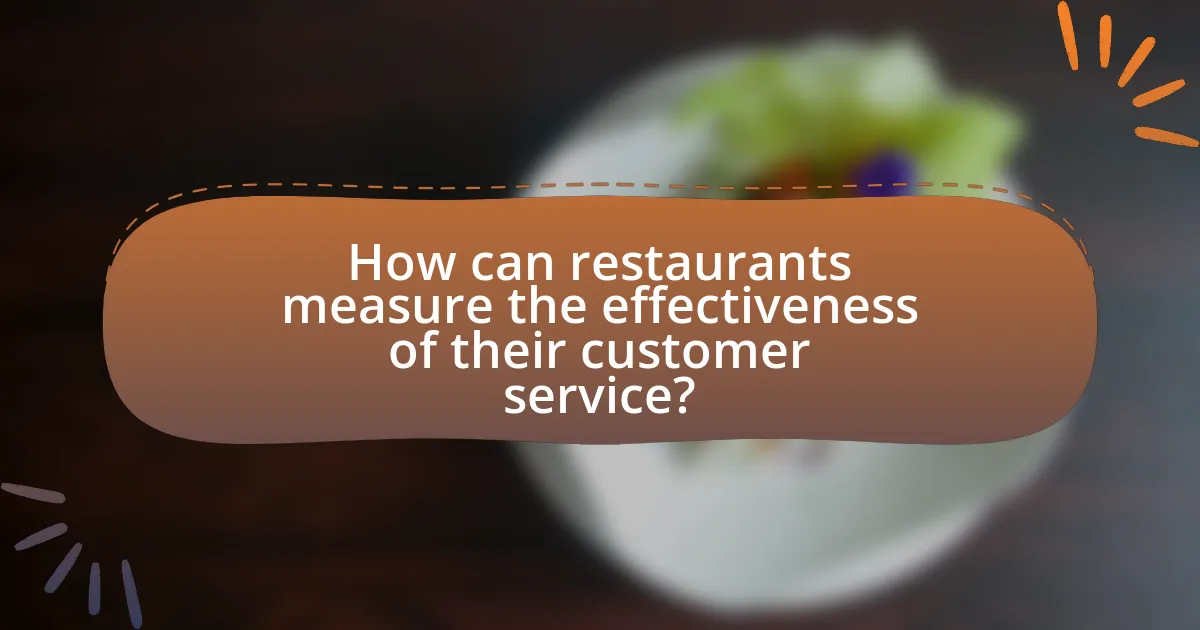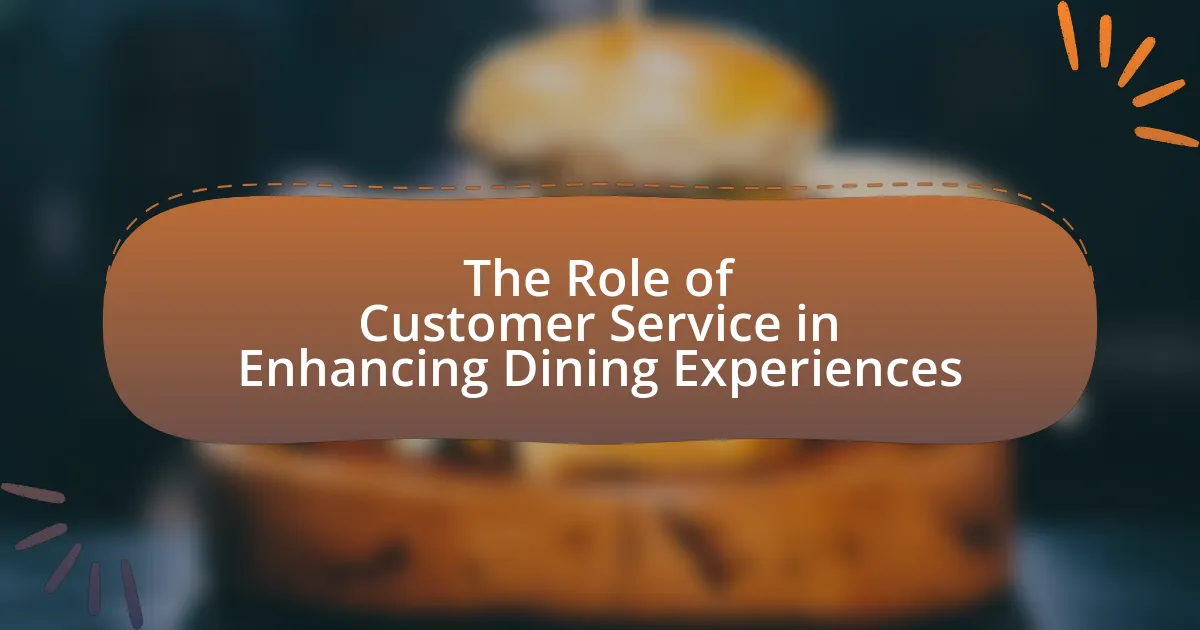The main entity of the article is customer service and its critical role in enhancing dining experiences. The article outlines how effective customer service directly influences customer satisfaction and loyalty, with research indicating that positive service experiences significantly impact diners’ decisions to return to restaurants. Key aspects such as attentiveness, friendliness, and efficiency are discussed as essential components of customer service that contribute to a positive dining experience. Additionally, the article highlights the importance of staff training, effective communication, and the use of technology in improving service quality, ultimately emphasizing that exceptional customer service is vital for restaurant success and competitive differentiation.

What is the Role of Customer Service in Enhancing Dining Experiences?
Customer service plays a crucial role in enhancing dining experiences by directly influencing customer satisfaction and loyalty. Effective customer service creates a welcoming atmosphere, addresses customer needs promptly, and fosters positive interactions between staff and diners. Research indicates that 70% of customers cite positive service experiences as a key factor in their decision to return to a restaurant (American Express, 2017). Additionally, attentive service can lead to higher tips and increased sales, as satisfied customers are more likely to spend more and recommend the establishment to others. Thus, exceptional customer service is integral to creating memorable dining experiences that encourage repeat business and positive word-of-mouth.
How does customer service impact the overall dining experience?
Customer service significantly impacts the overall dining experience by influencing customer satisfaction and loyalty. Positive interactions with staff can enhance a guest’s perception of the restaurant, leading to higher satisfaction ratings. According to a study published in the Journal of Hospitality & Tourism Research, 70% of customers reported that attentive service improved their dining experience, while 50% stated they would return to a restaurant primarily due to excellent service. This demonstrates that effective customer service not only enhances immediate satisfaction but also fosters repeat business, ultimately contributing to the restaurant’s success.
What specific aspects of customer service contribute to a positive dining experience?
Specific aspects of customer service that contribute to a positive dining experience include attentiveness, friendliness, and efficiency. Attentiveness ensures that customers feel valued and their needs are promptly addressed, which can lead to higher satisfaction levels. Friendliness fosters a welcoming atmosphere, encouraging repeat visits; studies show that 70% of customers cite friendly service as a key factor in their dining experience. Efficiency minimizes wait times and enhances the overall flow of the dining experience, with research indicating that quicker service can lead to increased customer satisfaction and higher tips for staff.
How do customer interactions influence guest satisfaction?
Customer interactions significantly influence guest satisfaction by shaping perceptions of service quality and overall experience. Positive interactions, characterized by attentive service, effective communication, and personalized attention, lead to higher levels of guest satisfaction. Research indicates that 70% of customer satisfaction is based on how they feel they are treated, highlighting the importance of interpersonal engagement in the dining context. Furthermore, studies show that guests who experience friendly and responsive service are more likely to return and recommend the establishment, thereby reinforcing the direct correlation between customer interactions and satisfaction levels.
Why is customer service essential in the restaurant industry?
Customer service is essential in the restaurant industry because it directly influences customer satisfaction and loyalty. Positive interactions with staff can enhance the overall dining experience, leading to repeat business and positive word-of-mouth referrals. According to a study by the National Restaurant Association, 70% of customers say they would return to a restaurant due to excellent service, highlighting the critical role that customer service plays in driving revenue and sustaining business growth.
What are the key benefits of excellent customer service for restaurants?
Excellent customer service for restaurants leads to increased customer satisfaction, loyalty, and positive word-of-mouth. When diners receive attentive and friendly service, they are more likely to enjoy their experience, which can result in repeat visits. According to a study by the American Express Global Customer Service Barometer, 70% of Americans are willing to spend more with companies they believe provide excellent customer service. Additionally, satisfied customers often share their experiences with others, enhancing the restaurant’s reputation and attracting new patrons. This cycle of satisfaction and referral can significantly boost a restaurant’s revenue and long-term success.
How does customer service differentiate restaurants in a competitive market?
Customer service differentiates restaurants in a competitive market by creating unique customer experiences that foster loyalty and positive word-of-mouth. High-quality customer service leads to increased customer satisfaction, which is crucial in a market where consumers have numerous dining options. According to a study by the American Express Global Customer Service Barometer, 70% of consumers are willing to spend more with companies that provide excellent customer service. This indicates that exceptional service not only attracts customers but also encourages them to return, thereby enhancing a restaurant’s competitive edge.

What are the key elements of effective customer service in dining?
The key elements of effective customer service in dining include attentiveness, communication, and problem resolution. Attentiveness ensures that staff are aware of customer needs and can respond promptly, enhancing the overall dining experience. Effective communication involves clear and friendly interactions between staff and customers, which fosters a welcoming atmosphere. Problem resolution is crucial; when issues arise, staff must address them swiftly and satisfactorily to maintain customer satisfaction. Research indicates that restaurants with high customer service ratings see a 20% increase in repeat business, demonstrating the direct impact of these elements on customer loyalty and overall success.
How can staff training improve customer service in restaurants?
Staff training can significantly improve customer service in restaurants by equipping employees with essential skills and knowledge to meet customer needs effectively. Trained staff are more adept at communication, problem-solving, and understanding menu offerings, which enhances the overall dining experience. For instance, a study by the National Restaurant Association found that 70% of customers are likely to return to a restaurant where they received excellent service, highlighting the direct correlation between staff training and customer satisfaction. Additionally, well-trained employees can handle complaints more efficiently, leading to higher customer retention rates and positive word-of-mouth referrals.
What skills should restaurant staff develop for better customer service?
Restaurant staff should develop communication, empathy, problem-solving, and multitasking skills for better customer service. Effective communication enables staff to clearly convey information and understand customer needs, which is essential in a fast-paced environment. Empathy allows staff to connect with customers on a personal level, enhancing their dining experience by making them feel valued. Problem-solving skills are crucial for addressing customer complaints and ensuring satisfaction, as studies show that resolving issues effectively can lead to increased customer loyalty. Lastly, multitasking skills help staff manage various responsibilities simultaneously, ensuring timely service and a smooth operation. These skills collectively contribute to a positive dining experience, as evidenced by research indicating that high-quality customer service directly correlates with customer retention and satisfaction in the restaurant industry.
How does ongoing training affect service quality?
Ongoing training significantly enhances service quality by equipping employees with the necessary skills and knowledge to meet customer expectations effectively. When staff undergo continuous training, they become more proficient in service protocols, product knowledge, and customer interaction techniques, leading to improved customer satisfaction. Research indicates that organizations investing in ongoing training experience a 24% increase in customer satisfaction scores, as trained employees are better prepared to handle inquiries and resolve issues promptly. This correlation between training and service quality underscores the importance of investing in employee development to foster a positive dining experience.
What role does communication play in customer service?
Communication is essential in customer service as it facilitates understanding and builds relationships between service providers and customers. Effective communication ensures that customer needs are accurately identified and addressed, leading to higher satisfaction levels. According to a study by the International Journal of Hospitality Management, 70% of customers cite effective communication as a key factor in their overall dining experience. This highlights that clear and timely communication can significantly enhance customer loyalty and retention in the dining sector.
How can effective communication enhance guest interactions?
Effective communication enhances guest interactions by fostering clarity, building rapport, and ensuring that guests feel valued. When staff communicate effectively, they can accurately convey menu details, address guest inquiries, and respond to feedback, which leads to a more satisfying dining experience. Research indicates that 70% of customers cite effective communication as a key factor in their overall satisfaction with service (American Express, 2021). This demonstrates that clear and engaging communication not only improves guest interactions but also positively impacts customer loyalty and repeat business.
What are common communication barriers in dining settings?
Common communication barriers in dining settings include noise, language differences, and non-verbal cues. Noise from the environment, such as background music or conversations, can hinder the ability to hear and understand others, leading to miscommunication. Language differences arise when staff and customers do not share a common language, complicating the ordering process and customer inquiries. Non-verbal cues, such as body language and facial expressions, may be misinterpreted, affecting the overall interaction and service quality. These barriers can significantly impact customer satisfaction and the dining experience.

How can restaurants measure the effectiveness of their customer service?
Restaurants can measure the effectiveness of their customer service through customer feedback surveys, online reviews, and performance metrics such as response time and order accuracy. Customer feedback surveys provide direct insights into guest satisfaction, allowing restaurants to quantify service quality through ratings and comments. Online reviews on platforms like Yelp and Google offer a broader perspective on customer experiences, with an average of 90% of consumers reading online reviews before visiting a restaurant. Performance metrics, including average wait times and the percentage of orders delivered correctly, can be tracked to assess operational efficiency and service quality. These methods collectively enable restaurants to identify strengths and areas for improvement in their customer service.
What metrics are used to evaluate customer service performance?
Key metrics used to evaluate customer service performance include Customer Satisfaction Score (CSAT), Net Promoter Score (NPS), First Response Time (FRT), and Customer Effort Score (CES). CSAT measures customer satisfaction through surveys, often asking customers to rate their experience on a scale. NPS assesses customer loyalty by asking how likely customers are to recommend a service to others, providing insight into overall satisfaction and potential for growth. FRT tracks the time taken to respond to customer inquiries, indicating efficiency in service. CES evaluates how easy it is for customers to resolve their issues, reflecting the effectiveness of the service process. These metrics are widely recognized in the industry for their ability to provide actionable insights into customer service performance.
How can customer feedback be effectively collected and analyzed?
Customer feedback can be effectively collected and analyzed through structured surveys, direct interviews, and digital feedback tools. Structured surveys, often distributed via email or in-app notifications, allow businesses to gather quantitative data on customer satisfaction and preferences. Direct interviews provide qualitative insights, enabling deeper understanding of customer experiences. Digital feedback tools, such as social media platforms and review sites, facilitate real-time feedback collection and analysis. According to a study by the Harvard Business Review, companies that actively seek and analyze customer feedback can increase customer retention rates by up to 5%, demonstrating the importance of effective feedback mechanisms in enhancing customer service and dining experiences.
What role do online reviews play in assessing customer service?
Online reviews significantly influence the assessment of customer service by providing real-time feedback from consumers. These reviews serve as a reflection of customer experiences, allowing potential patrons to gauge the quality of service before making dining decisions. Research indicates that 84% of people trust online reviews as much as personal recommendations, highlighting their impact on consumer behavior. Furthermore, platforms like Yelp and TripAdvisor aggregate these reviews, enabling restaurants to identify strengths and weaknesses in their service, ultimately guiding improvements and enhancing the overall dining experience.
What strategies can restaurants implement to improve customer service?
Restaurants can implement training programs for staff to enhance customer service. Effective training equips employees with skills in communication, problem-solving, and product knowledge, which are essential for providing exceptional service. Research indicates that well-trained staff can increase customer satisfaction by up to 20%, as they are better prepared to meet customer needs and handle complaints efficiently. Additionally, implementing a feedback system allows restaurants to gather insights from customers, enabling continuous improvement in service quality.
How can technology be leveraged to enhance customer service?
Technology can be leveraged to enhance customer service by implementing tools such as chatbots, customer relationship management (CRM) systems, and mobile applications. Chatbots provide instant responses to customer inquiries, improving response times and availability, which is crucial in the dining industry where timely service can significantly impact customer satisfaction. CRM systems enable restaurants to track customer preferences and feedback, allowing for personalized service that can enhance the dining experience. Additionally, mobile applications facilitate online reservations and order placements, streamlining the customer journey and reducing wait times. According to a study by the National Restaurant Association, 70% of consumers prefer to order food online, highlighting the importance of technology in meeting customer expectations and improving service efficiency.
What are some best practices for creating a customer-centric culture?
To create a customer-centric culture, organizations should prioritize understanding customer needs and preferences through regular feedback mechanisms. Implementing surveys, focus groups, and direct communication channels allows businesses to gather insights that inform service improvements. Additionally, training employees to empathize with customers and respond effectively to their concerns fosters a supportive environment. Research indicates that companies with strong customer-centric cultures, such as Amazon, see higher customer loyalty and satisfaction rates, which directly correlate with increased revenue. By embedding customer feedback into decision-making processes and empowering staff to act on it, businesses can enhance their dining experiences and build lasting relationships with customers.
What are practical tips for enhancing customer service in dining experiences?
To enhance customer service in dining experiences, restaurants should prioritize staff training, effective communication, and personalized service. Staff training ensures that employees are knowledgeable about the menu and can provide recommendations, which improves customer satisfaction. Effective communication, including active listening and responding promptly to customer needs, fosters a welcoming atmosphere. Personalized service, such as remembering regular customers’ preferences, creates a memorable dining experience. According to a study by the National Restaurant Association, 70% of customers are more likely to return to a restaurant that provides excellent service, highlighting the importance of these practices in driving customer loyalty.
